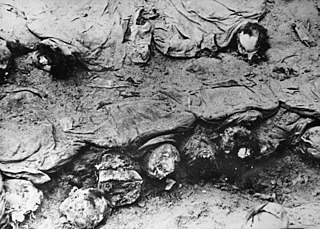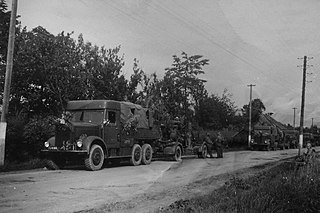
The Gulag was a system of forced labor camps in the Soviet Union. The word Gulag originally referred only to the division of the Soviet secret police that was in charge of running the forced labor camps from the 1930s to the early 1950s during Joseph Stalin's rule, but in English literature the term is popularly used for the system of forced labor throughout the Soviet era. The abbreviation GULAG (ГУЛАГ) stands for "Гла́вное Управле́ние исправи́тельно-трудовы́х ЛАГере́й", but the full official name of the agency changed several times.

The Ukrainian Insurgent Army was a Ukrainian nationalist paramilitary and partisan formation founded by the Organisation of Ukrainian Nationalists on October 14, 1942. During World War II, it was engaged in guerrilla warfare against the Soviet Union, and both the Polish Underground State and Communist Poland.
Soviet partisans were members of resistance movements that fought a guerrilla war against Axis forces during World War II in the Soviet Union, the previously Soviet-occupied territories of interwar Poland in 1941–45 and eastern Finland. The activity emerged after Nazi Germany's Operation Barbarossa was launched from mid-1941 on. It was coordinated and controlled by the Soviet government and modeled on that of the Red Army.
During World War II, resistance movements operated in German-occupied Europe by a variety of means, ranging from non-cooperation to propaganda, hiding crashed pilots and even to outright warfare and the recapturing of towns. In many countries, resistance movements were sometimes also referred to as The Underground.

A partisan is a member of an irregular military force formed to oppose control of an area by a foreign power or by an army of occupation by some kind of insurgent activity.
The Jaworzno concentration camp was a concentration camp in WW2 German-occupied Poland and later in Communist Poland. It was first established by the Nazis in 1943 during the Second World War and was later used from 1945 to 1956 by the Soviet NKVD and then by the Ministry of Public Security and other agencies of the Polish communist regime. Today the site is an apartment complex and also houses a memorial to the camp's victims.

The Belarusian resistance during World War II opposed Nazi Germany from 1941 until 1944. Belarus was one of the Soviet republics occupied during Operation Barbarossa. The term Belarusian partisans may refer to Soviet-formed irregular military groups fighting Germany, but has also been used to refer to the disparate independent groups who also fought as guerrillas at the time, including Jewish groups, Polish groups, and nationalist Belarusian forces opposed to Germany.

In Poland, the resistance movement during World War II was led by the Home Army. The Polish resistance is notable among others for disrupting German supply lines to the Eastern Front, and providing intelligence reports to the British intelligence agencies. It was a part of the Polish Underground State.

The war crimes and crimes against humanity which were perpetrated by the Soviet Union and its armed forces from 1919 to 1991 include acts which were committed by the Red Army as well as acts which were committed by the country's secret police, NKVD, including its Internal Troops. In many cases, these acts were committed upon the orders of the Soviet leaders Vladimir Lenin and Joseph Stalin in pursuance of the early Soviet government's policy of Red Terror. In other instances they were committed without orders by Soviet troops against prisoners of war or civilians of countries that had been in armed conflict with the USSR, or they were committed during partisan warfare.

Dmitry Nikolaevich Medvedev was one of the leaders of the Soviet partisan movement in western Russia and Ukraine.

After World War II there were from 560,000 to 760,000 Japanese personnel in the Soviet Union and Mongolia interned to work in labor camps as POWs. Of them, it is estimated that between 60,000 and 347,000 died in captivity.
On May 21, 1945, a unit of the Polish Home Army, led by Colonel Edward Wasilewski, attacked a Soviet NKVD camp located in Rembertów in the eastern outskirts of Warsaw. Hundreds of Polish citizens had been imprisoned there, including members of the Home Army and other members of the underground resistance. Prisoners at the camp were being systematically deported to Siberia. As a result of the attack, all of the Polish political prisoners were freed from the camp by the pro-independence resistance.
The Main Administration for Affairs of Prisoners of War and Internees was an NKVD department in charge of handling of foreign civilian internees and prisoners of war (POWs) in the Soviet Union during and in the aftermath of World War II (1939–1953).

The anti-communist resistance in Poland, also referred to as the Polish anti-communist insurrection fought between 1944 and 1953, was an anti communist and anti-soviet armed struggle by the Polish Underground against the Soviet domination of Poland by the People's Republic of Poland puppet regime, since the end of World War II in Europe. The guerrilla warfare conducted by the resistance movement formed during the war, included an array of military attacks launched against communist prisons, state security offices, detention facilities for political prisoners, and prison camps set up across the country by the Stalinist authorities.

Anti-Soviet partisans may refer to various resistance movements that opposed the Soviet Union and its satellite states at various periods during the 20th century.

Lithuanian partisans were partisans who waged guerrilla warfare in Lithuania against the Soviet Union in 1944–1953. Similar anti-Soviet resistance groups, also known as Forest Brothers and cursed soldiers, fought against Soviet rule in Estonia, Latvia and Poland. An estimated total of 30,000 Lithuanian partisans and their supporters were killed. The Lithuanian partisan war lasted almost for a decade, thus becoming one of the longest partisan wars in Europe.

The guerrilla war in the Baltic states was an insurgency waged by Baltic partisans against the Soviet Union from 1944 to 1956. Known alternatively as the "Forest Brothers", the "Brothers of the Wood" and the "Forest Friars", these partisans fought against invading Soviet forces during their occupation of the Baltic states during and after World War II. Similar insurgent groups resisted Soviet occupations in Bulgaria, Poland, Romania and Ukraine.

The People's Commissariat for Internal Affairs, abbreviated NKVD, was the interior ministry of the Soviet Union.

The Slovak National Uprising was a military uprising organized by the Slovak resistance movement during World War II in central Slovakia. This resistance movement was represented mainly by members of the Democratic Party, social democrats, and communists. It was launched on 29 August 1944 from Banská Bystrica in an attempt to resist German troops that had occupied Slovak territory and to overthrow the collaborationist government of Jozef Tiso. Although the resistance was largely defeated by German forces, guerrilla operations continued until the Red Army, Czechoslovak Army and Romanian Army occupied the Slovak Republic in 1945.
Operation Zeppelin was a top secret German plan to recruit Soviet prisoners of war (POWs) for espionage and sabotage operations behind the Russian front line during World War II. Active from mid-1942 to the end of the war in spring 1945, the operation initially intended to send masses of agents to Soviet Russia to collect military intelligence and to counterbalance sabotage activities carried out by the Soviet partisans. To that end, Germans recruited thousands of Soviet POWs and trained them in special camps. However, this approach had to be abandoned in favor of more targeted operations due to a lack of reliable Soviet recruits and dwindling resources, such as aircraft fuel. Operation Zeppelin was particularly important for intelligence gathering in the Eastern Front, but its more ambitious missions yielded little results. It had some success in the Caucasus where the various peoples of the Caucasus aspired to become independent from the Soviet Union, but other missions, such as sabotage of power plants near Moscow or a plot to assassinate Joseph Stalin, were abandoned or failed. A particular failure was the desertion of the Brigade SS Druzhina in August 1943.













